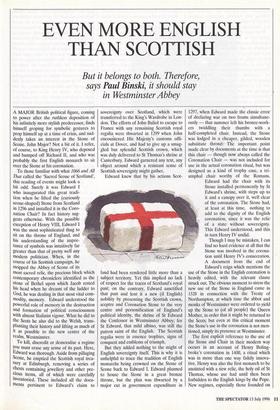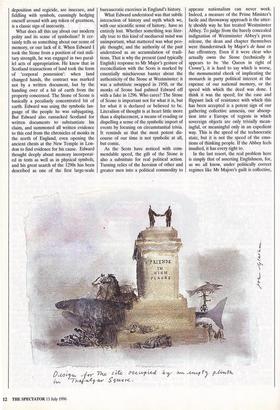EVEN MORE ENGLISH THAN SCOTTISH
But it belongs to both. Therefore, says Paul Binski, it should stay in Westminster Abbey
A MAJOR British political figure, coming to power after the ruthless deposition of his infinitely more stylish predecessor, finds himself groping for symbolic gestures to prop himself up at a time of crisis, and sud- denly takes an interest in the Stone of Scone. John Major? Not a bit of it. I refer, of course, to King Henry IV, who deposed and bumped off Richard II, and who was probably the first English monarch to sit over the Stone at his coronation.
To kill, discredit or demoralise a regime you must erase any sense of its past. Here, Edward was thorough. Aside from pillaging Scone, he emptied the Scottish royal trea- sury at Edinburgh, removing a series of chests containing jewellery and other pre- cious items, all of which were carefully inventoried. These included all the docu- ments pertinent to Edward's claim to sovereignty over Scotland, which were transferred to the King's Wardrobe in Lon- don. The efforts of John Baliol to escape to France with any remaining Scottish royal regalia were thwarted in 1299 when John encountered His Majesty's customs offi- cials at Dover, and had to give up a smug- gled but splendid Scottish crown, which was duly delivered to St Thomas's shrine at Canterbury. Edward garnered any text, any object around which a resistant sense of Scottish sovereignty might gather.
Edward knew that by his actions Scot- land had been rendered little more than a subject territory. Yet this implied no lack of respect for the traces of Scotland's royal past; on the contrary, Edward sanctified that past and lent it a new (if English) nobility by presenting the Scottish crown, sceptre and Coronation Stone to the very centre and personification of England's political identity, the shrine of St Edward the Confessor in Westminster Abbey; for St Edward, that mild albino, was still the patron saint of the English. The Scottish regalia were in essence trophies, signs of conquest and emblems of triumph.
But they added nothing to the might of English sovereignty itself. This is why it is unhelpful to trace the tradition of English monarchs being crowned on the Stone of Scone back to Edward I. Edward planned to house the Stone in a great bronze throne, but the plan was thwarted by a major cut in government expenditure in 1297, when Edward made the classic error of declaring war on two fronts simultane- ously — that summer left his bronze-work- ers twiddling their thumbs with a half-completed chair. Instead, the Stone was lodged in a cheaper, gilded, wooden substitute throna The important point made clear by documents at the time is that this chair — though now always called the Coronation Chair — was not included for use in the actual coronation ritual, but was designed as a kind of trophy case, a tri- umphal chair worthy of the Romans. Edward had the chair with its Stone installed permanently by St Edward's shrine, with steps up to it and a canopy over it, well clear of the coronation. The Stone had, at least at this time, nothing to add to the dignity of the English coronation, since it was the relic of a state without sovereignty. This Edward understood, and this in turn Henry IV undid.
Though I may be mistaken, I can find no hard evidence at all that the Stone was involved in the corona- tion until Henry IV's consecration. A document from the end of Edward's reign which mentions the use of the Stone in the English coronation is heavily edited, with the relevant clause struck out. The obvious moment to stress the new use of the Stone in England came in 1328 in connection with the Treaty of Northampton, at which time the abbot and monks of Westminster were ordered to yield up the Stone to (of all people) the Queen Mother, in order that it might be returned to the Scots; but even at this critical moment the Stone's use in. the coronation is not men- tioned, simply its presence at Westminster. The first explicit reference to the use of the Stone and Chair in their modern way occurs in an account of Henry Boling- broke's coronation in 1400, a ritual which was in more than one way fishily innova- tive. Henry was also the first monarch to be anointed with a Mew relic, the holy oil of St Thomas, whose use had until then been forbidden to the English kings by the Pope. New regimes, especially those founded on deposition and regicide, are insecure, and fiddling with symbols, cunningly hedging oneself around with any token of greatness, is a classic sign of insecurity.
What does all this say about our modern polity and its sense of symbolism? It cer- tainly tells us something about our sense of memory, or our lack of it. When Edward I took the Stone from a position of vast mili- tary strength, he was engaged in two paral- lel acts of appropriation. He knew that in Scotland transactions of land took the form of 'corporal possession': when land changed hands, the contract was marked not by a written document, but by the handing over of a bit of earth from the property concerned. The Stone of Scone is basically a peculiarly concentrated bit of earth. Edward was using the symbolic lan- guage of the people he was subjugating. But Edward also ransacked Scotland for written documents to substantiate his claim, and summoned all written evidence to this end from the chronicles of monks in the north of England, even opening the ancient chests at the New Temple in Lon- don to find evidence for his cause. Edward thought deeply about memory incorporat- ed in texts as well as in physical symbols, and his great search of the 1290s has been described as one of the first large-scale bureaucratic exercises in England's history. What Edward understood was that subtle interaction of history and myth which we, with our scientific sense of history, have so entirely lost. Whether something was liter- ally true to this kind of mediaeval mind was unimportant, what mattered was what peo- ple thought, and the authority of the past understood as an accumulation of tradi- tions. That is why the present (and typically English) response to Mr Major's gesture of reconciliation with the Scots is marked by essentially mischievous banter about the authenticity of the Stone at Westminster: it was a substitute swapped in 1950, or the monks of Scone had palmed Edward off with a fake in 1296. Who cares? The Stone of Scone is important not for what it is, but for what it is declared or believed to be. Literalism of thought is at heart little more than a displacement, a means of evading or dispelling a sense of the symbolic import of events by focusing on circumstantial trivia. It reminds us that the most potent dis- course of our time is not symbolic at all, but comic.
As the Scots have noticed with com- mendable speed, the gift of the Stone is also a substitute for real political action. Turning relics of the heroism of other and greater men into a political commodity to
appease nationalism can never work. Indeed, a measure of the Prime Minister's facile and throwaway approach is the utter- ly shoddy way he has treated Westminster Abbey. To judge from the barely concealed indignation of Westminster Abbey's press release, the dean and chapter themselves were thunderstruck by Major's de haul en bas effrontery. Even if it were clear who actually owns the Stone (technically it appears to be 'the Queen in right of Crown'), it is hard to say which is worse, the monumental cheek of implicating the monarch in party political interest at the expense of our national memory, or the speed with which the deed was done. I think it was the speed; for the ease and flippant lack of resistance with which this has been accepted is a potent sign of our gathering collective amnesia, our absorp- tion into a Europe of regions in which sovereign objects are only trivially mean- ingful, or meaningful only in an expedient way. This is the speed of the technocratic state, but it is not the speed of the emo- tions of thinking people. If the Abbey feels insulted, it has every right to.
In the last resort, the real problem here is simply that of asserting Englishness, for, as we all know, under politically correct regimes like Mr Majors's guilt is collective,
national and inheritable, and we all owe the Scots something. Well, I for one like the Scots, but I still feel that the case for the Englishness of the Stone of Scone can be argued. Edward I honoured the Stone, sanctified it by presenting it to England's patron saint, and dramatised its setting. Westminster Abbey has proudly asserted the tradition of its use at coronations ever since, and generations of tourists have inscribed their initials on the Coronation Chair (you could once pay the verger a penny to do your initials). We appropriated the Stone — but we also assimilated it and lent it a new nobility, and, perhaps, even preserved it.
In this sense, the analogy with the Elgin marbles is a good one, for precisely the same argument holds there too: the facts surrounding an object's acquisition need not necessarily colour its subsequent his- tory, or the sense of affection, worth and continuity which surrounds it. Once a host culture has come to use and under- stand something in that kind of way, that culture undoubtedly does have a claim to it. After 700 years, the Stone is now quite as much English as Scottish, and this is something to which Mr Major is quite blind: if ever a symbol were needed of the Union governed from Westminster, it was the Stone. But all may not be lost. We could always nick it back. Besides, the Stone of Destiny (which is after all a Celtic magical object) can bring ill luck as well as good. The mediaeval writer Adam of Usk recalled that the sacred chrism used at Henry IV's innovative coronation Produced in his hair a giant crop of lice, eradicated only with difficulty. Eventual- ly, he dropped dead in the Abbot's House at Westminster. You tinker with symbols at your peril, Mr Major.
Paul Binski is Fellow of Caius, Cambridge and author of Westminster Abbey and the Plantagenets: Kingship and the Represen- tation of Power (Yale, 1995).
'I6 about a journalist who tries to pin down Tony Blair on Labour policy.'




































































 Previous page
Previous page